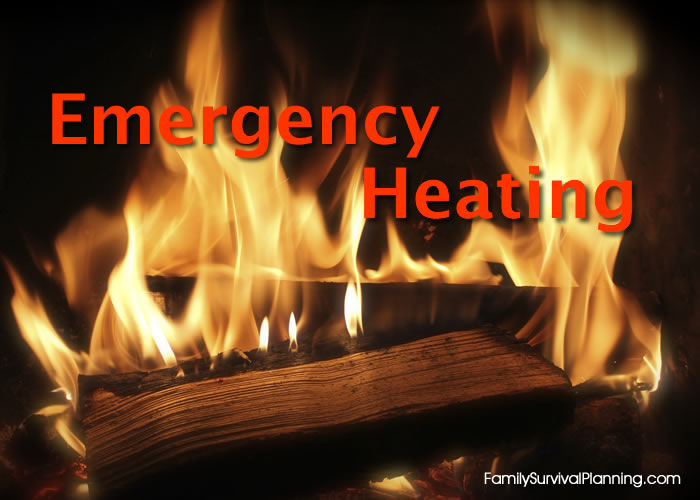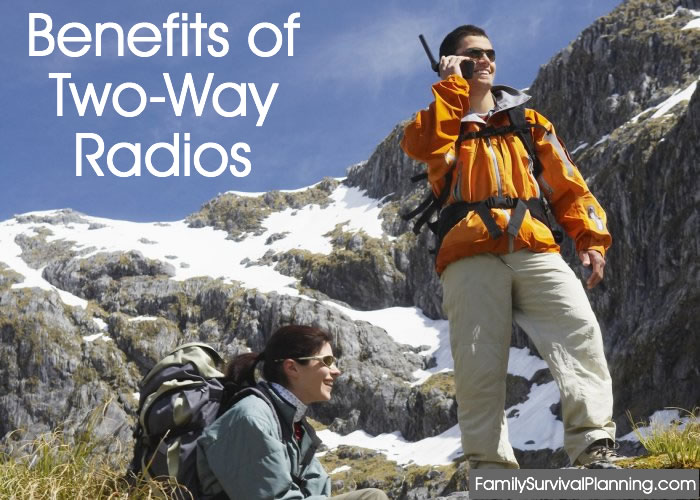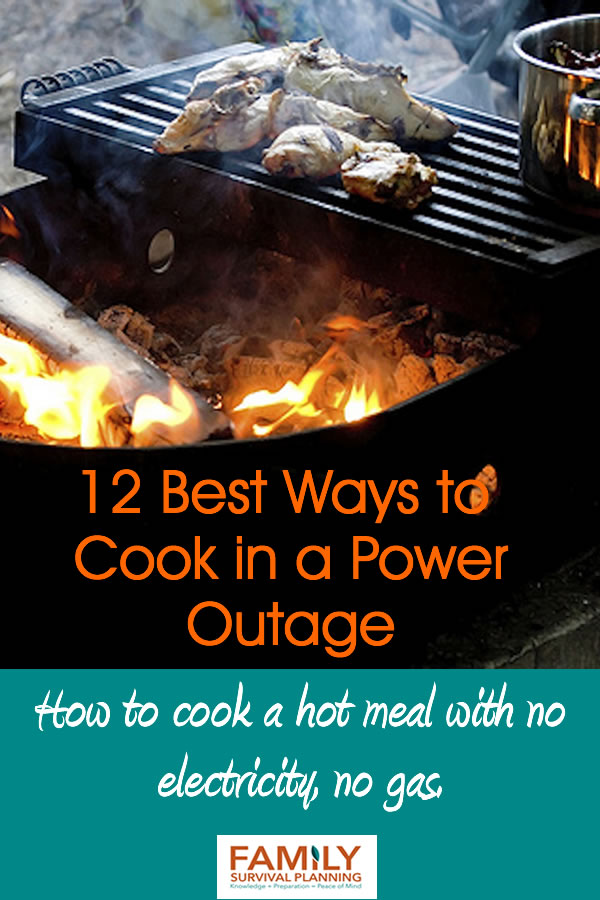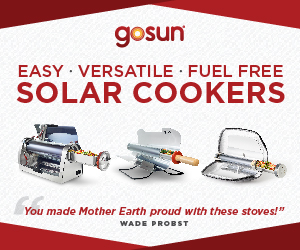- HOME
- Survival Gear
- Emergency Heating
Emergency Heating: How To Keep Warm in a Power Outage

Depending on where you live, you may need to have emergency heating options if the power goes out during the winter.
Besides winter, many disasters involve conditions that may knock out your electricity which would include the furnace.
Invest in emergency food storage now and enjoy peace of mind for the next 25 years. Don't miss out on the savings!
It could be a real challenge to stay warm when the furnace hasn't worked for days and the temperatures are dropping due to winter storms, hurricanes, tornadoes, floods, earthquakes, etc.
Does your survival plan include a variety of ways to keep your family warm?
I would suggest that several of these ideas be added to your survival plans. Back ups of back ups is always a good plan.
In planning for emergencies for your family, remember to put some of the items suggested below into your 72-hour kits.
Take advantage of your body's natural heat.
Blankets and Quilts
Have a good supply of blankets, comforters, and quilts on hand. Comforters and quilts are stuffed with batting in layers which increases their warmth capacity. Several layered blankets can have the same effect as a thick quilt or comforter.
If you are an electric blanket person, think ahead and have a backup plan in mind because you may not have enough regular non-electric blankets to stay warm when the electricity is out. If you don't think you have enough room to store extra blankets, try laying them out flat between your mattress and box springs when they're not in use.
Layered Clothing
Several lighter layers of clothing will provide more warmth than one thick layer. Layering everyday clothes will trap body warmth. Thermal underwear is a good thing to start with, or at least a t-shirt. Add sweat pants and a sweatshirt. Top those with a pair of pants and a flannel shirt. Add a sweater or jacket. Fleece is a good choice for layering because it keeps insulating, even if it gets damp. Avoid tight clothing when you're layering - it doesn't leave pockets of air to be trapped for insulation.
- On your feet, start with a thin pair of socks, followed by a thick pair of socks - maybe even two; thermal socks if you have them. Finish up your feet with warm slippers when you're inside and dry boots when you're outside.
- Wear a hat all the time. Hats help trap body heat, which is important since almost 90% of the body's heat is lost through the head. Hats are especially important for toddlers, babies, or someone who is bedridden. Keep their heads covered, particularly at night while sleeping.
- Have several pairs of gloves, some for inside that can stay dry, and a pair for outdoors where they may get wet.
Ok - so now you look like the Pillsbury dough-boy. But no one will laugh if you're all warm together!
Sleeping Bags

If you are a camping family, you will already have sleeping bags handy. If you are not into camping, buying sleeping bags for each family member is a good idea anyway. Be sure and check the cold-weather rating, taking into consideration the year-round temperatures in your area.
Be sure and check to make sure your sleeping bags are in good condition - before you need them. Who used them last? Your Boy Scout? Your daughter at the last slumber party? You don't want surprises in sleeping bags when an emergency comes.
An emergency survival sleeping bag is an essential outdoor accessory and is very inexpensive. In emergencies, it can be used as an improvised sleeping bag, sleeping bag cover, shelter, solar still or as a signaling device.
Space Blankets

You are probably familiar with the small, compact, metallic emergency blankets, also known as "space blankets" or "emergency bivvy". They are readily available in sporting goods stores or wherever emergency supplies are sold.
It seems illogical that something that small and thin could keep a person warm, but they do. NASA designed the technology for use in the space program, and it works by containing almost all of your body heat.
Their drawback is that they don't "feel" like a blanket. You don't get the same physical and emotional comfort wrapping up in foil that you do wrapping up in a regular blanket or quilt. However, because of their small, thin size, they are ideal for emergency situations. Buy plenty of them as they are inexpensive and do tear easily - and pack them into your 72-hour kit.
Chemical Hand and Body Warmers

It seems that if you can keep your hands, feet, and head warm, the rest of your body will feel warm too. Hats work well for your head, and gloves work to some extent for your hands. But if it's really cold, buy some small hand warmers. They are small enough to fit into your glove, shoe, or slippers, or drop them into your pocket if you're not wearing gloves. Once activated, they will provide heat for 8 to 12 hours.
Body warmers are a bit bigger (3" x 4") and when activated, heat to around 120-150 degrees F. Take them to a football game, slap it one on each shoulder under your clothes. You'll enjoy the entire game warm as toast - and then some. They last 18 hours or more!
Space Heaters
Kerosene Heaters

Kerosene heaters like the Dyna-Glo RMC-55R7 Indoor Kerosene Radiant Heater (10000 BTU) are more effective in a small space. A 10,000 BTU heater will be more than ample.
Some kerosene heaters that are 23,000 BTUs or more are too much heat for one room and some cannot be turned down to a lower heat. Be sure to follow directions for safety if you plan to use this type.
Kerosene heater products need to be used with caution indoors. They are perfectly safe if used in a big open area, like the living room or family room. But when using in a small closed room, it can suck up all the oxygen and carbon monoxide can build up so it's necessary to crack open a window somewhere for ventilation.
A kerosene heater is not meant to heat the whole house and keep it toasty warm. It will adequately warm a smaller area to help keep you warm. It will keep you cozy and comfortable, even though it may be cold in other parts of the house.
Read more about Kerosene and Kerosene heaters here.
Propane Heaters

Stay warm indoors or outdoors in a power outage or other emergency with this Mr. Heater Portable Buddy, a Fuel Filter, and a 5' Hose Assembly. All you need is propane! It's lightweight, quiet and odor-free and heats about 200 square feet on a high setting (9,000 BTU) or use the low setting (4,000 BTU) for smaller areas. (Certified by CSA International (American Gas Association) for indoor and outdoor use.)

We have the Mr. Heater (like this one) that we can use all winter long when sitting out on our deck in 30 or 40 degree weather (providing it's not snowing or too windy). It uses a large or small propane tank and provides enough warmth to sit outside on a cold, sunny winter day.
From one happy user:
"The week before Hurricane Sandy hit, my cell phone was my favorite item. Once Sandy said hello we had no power for 3 weeks. Mr. Heater became the best item I owned. Without it my family would never had made it through those bitter nights. Blankets only help so much and a gas shortage made using generators difficult. The converter [propane heater] made using regular propane tanks a life saver. This is the most valuable item my family owns."
Posted by Jen
CAUTIONS for INDOOR HEATING:
- Never use propane heaters or charcoal stoves inside your home unless specifically stated for inside use..
- Do not use an oven or gas stove to heat a room.
- A battery operated carbon monoxide detector is a good investment.
Fireplaces and Wood Stoves
If you have a wood burning fireplace, it will usually only heat the room where it's located rather than the entire house. The exception might be a large wood stove in a central location. A friend of ours had just that situation. Their wood stove was located in the center of the house in the basement. Because heat rises, it did a pretty good job of heating the entire house.
A traditional fireplace is not really good for keeping you warm — it's more for ambiance. They can suck as much as 300 cubic feet of heated air per minute out of a room and then send it right up the chimney. A fireplace insert with a fan would work better, but then you are faced with the fan not working in a power outage.
A pellet stove, which is very efficient compared to a traditional fireplace, usually requires electricity to run fans, controls, and pellet feeder.
The biggest drawback of a fireplace or pellet stove in a long term power outage is the fuel it needs. When you run out, better have a back up method of keeping warm.
Live Only in One or Two Rooms
If it's very cold and you're not sure how long you will be without heat from your furnace, cut down on the size of the area you are trying to heat. Pull all your kids, in-laws, dogs, goldfish, sleeping bags, blankets, and pillows into one room. Do your eating, sleeping, worrying, playing, and reading in that room.
Close all the doors to the rooms not being used to conserve heat. Have some or all of these emergency heating methods ready to use at a moment's notice to keep your family warm.















